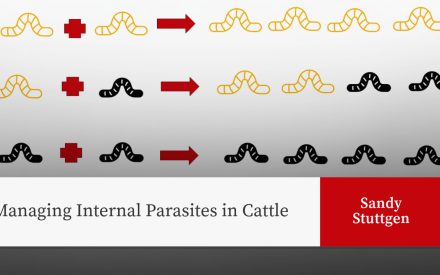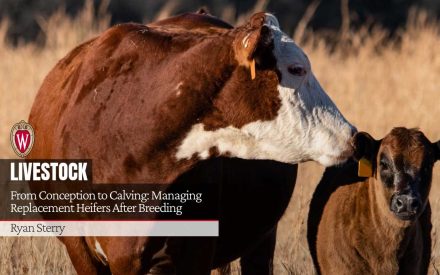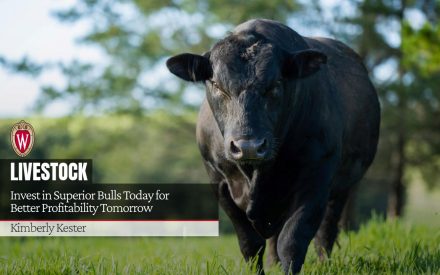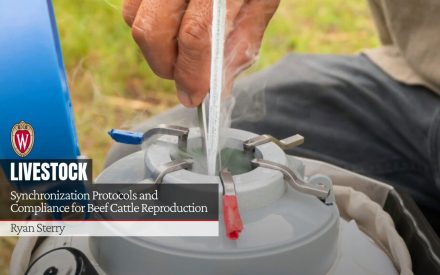Green is my favorite color. Green tree buds, lawns, and pastures signal that winter is finally over. It’s very tempting to turn young stock out onto newly green pasture. We are tired of indoor feeding and cleaning, and we have fieldwork and other chores to attend to. However, tempting as it is to open the pasture gate, first remember these worm management steps.
Step 1. Wait until the pasture is four inches in height and deworm before turning out youngstock
Parasitic worms (gastrointestinal helminths) especially hinder the growth of young animals. Some of the larvae that cattle deposited during the prior year’s grazing survive in fecal pats and under snow cover. These survivors are a source of new infestation the next spring. Once the soil temperature reaches 55 degrees and with the aid of moisture (morning dew or rain) the larvae migrate on grass stems (to at most four inches) to increase their chances of being consumed. You can reduce exposure to larvae by waiting for spring turnout onto pastures that are over four inches in height. Do not allow young stock to graze below four inches of residual plant height. You can also manage worm infestations by deworming young stock prior to spring turnout.
One helminth species, Ostertagia, will ‘hibernate’ within the gastrointestinal wall of cattle in a state of hypobiosis (suspended development). Hypobiotic larvae survive in cattle during suboptimal grass conditions or during the winter. As pasture environments improve in the spring, they emerge from their state of hypobiosis, resume reproduction, and pass eggs into feces. Once deposited on grass, these mature to infective larvae that cattle consume as they graze.
Step 2. Use Fecal Egg Counts to determine worm load and treatment
Fecal egg counts (FECs) and fecal egg count reduction tests (FECRTs) are used to determine current worm loads and the effectiveness of anthelmintic treatments. Before turnout, use FECs to determine the animals’ worm load. Collect fecal samples for testing when the grass begins growing as FECs need to be performed after the worms are out of their dormant stage and releasing eggs into feces. Work with your veterinarian to interpret the FEC results. If treatment is indicated, decide upon a suitable strategy that includes using FECRT to gauge efficacy of the treatment. FECRTs are conducted 14 days after treatment.
Cattle should remain in their dry lot until the FECRT results are known so that worms surviving treatment are not shedding anthelmintic-resistant eggs onto the pasture. Based on the FERCT results, your veterinarian may recommend treating them again with a different product before or after turnout. Sample feces again approximately one month after turnout to determine if new or resistant infestations have developed.
Step 3. Learn more with this resource
To learn more about managing gastrointestinal parasites, read the following publication
Resources
- https://pressbooks.umn.edu/vetprevmed/chapter/chapter-5-parasite-control/
- https://www.canr.msu.edu/news/beef_cattle_deworming_strategies
- Wang T, Avramenko RW, Redman EM, Wit J, Gilleard JS, Colwell DD. High levels of third-stage larvae (L3) overwinter survival for multiple cattle gastrointestinal nematode species on western Canadian pastures as revealed by ITS2 rDNA metabarcoding. Parasit Vectors. 2020 Sep 10;13(1):458. doi: 10.1186/s13071-020-04337-2. PMID: 32912326; PMCID: PMC7488095.
- Gibbs HC. Relative importance of winter survival of larval nematodes in pasture and infected carrier calves in a study of parasitic gastroenteritis in calves. Am J Vet Res. 1979 Feb;40(2):227-31. PMID: 464359.


 Managing Internal Parasites in Cattle
Managing Internal Parasites in Cattle From Conception to Calving: Managing Replacement Heifers After Breeding
From Conception to Calving: Managing Replacement Heifers After Breeding Invest in Superior Bulls Today for Better Profitability Tomorrow
Invest in Superior Bulls Today for Better Profitability Tomorrow Synchronization Protocols and Compliance for Beef Cattle Reproduction
Synchronization Protocols and Compliance for Beef Cattle Reproduction


